Recent Articles
Popular Makes
Body Types
2021 Land Rover Defender Road Test and Review
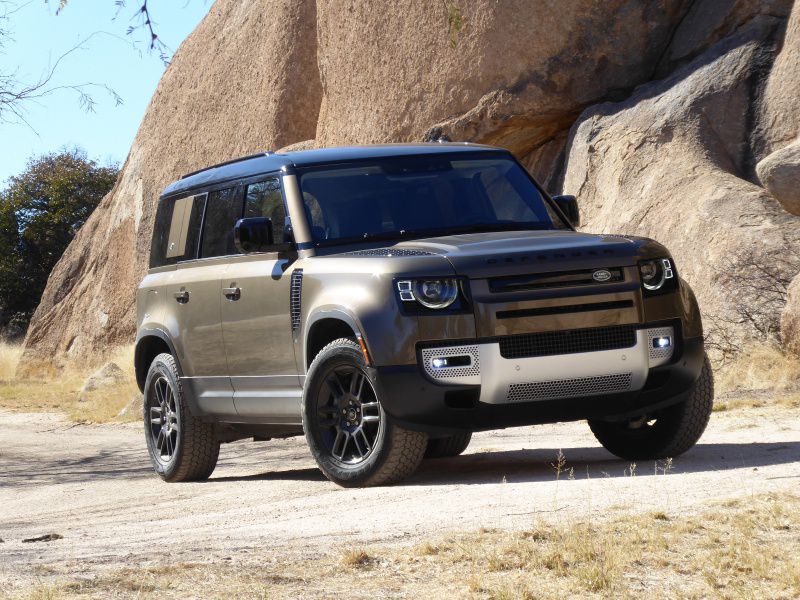
2021 Land Rover Defender ・ Photo by Ron Sessions
The 2021 Land Rover Defender is a purpose-built sport-utility available as the short-wheelbase two-door 90 model or the long-wheelbase four-door 110. The two-door seats five (or six with the optional front jump seat) while the four-door’s standard five-seat capacity can be expanded to eight with the front jump seat and optional third-row seat.
Introduced for the 2020 model year, the new Defender (dubbed L663 in Land Rover parlance) marks a return of the iconic, off-road-optimized four-wheel-drive SUV after a 23-year absence from the North American market. Except for its name, product position, and design inspiration, it shares nothing with the more basic L316 Defender sold in the U.S. from 1993 to ’97. The 2021 Defender is available in a wide range of trims including the base 90, 90 S, 90 X-Dynamic S, 90 First Edition, 90 X, base 110, 110 S, 110 SE, 110 X-Dynamic SE, 110 X-Dynamic HSE, and 110 X. Including the $1,350 destination charge, prices range from $47,450 for a base two-door Defender 90 to $84,350 for a loaded four-door Defender 110 X.
Styling and Design
Recalling the go-anywhere spirit and indomitable off-pavement capability of the first post-WWII Land Rovers, the new Defender celebrates the brand’s roots. The 2021 Defender’s short overhangs, impressive ground clearance, rear-mounted spare tire, and generous approach and departure angles give it the proportions to tackle steep and rugged off-road trails with ease.
Unlike the original Defender that featured aluminum sheet metal mounted to a truck-like steel ladder frame and live (solid) axles front and rear, the new version utilizes all-aluminum unitized construction and modern independent suspension at all four corners. There is no convertible body style as on the original, but both the short- and long-wheelbase hardtops are available with large sunroofs. A wide variety of accessories are available to personalize the Defender. These include a side-mounted gear carrier, a rooftop carrier, mud flaps, fixed side steps, a spare tire cover, and even a deployable roof ladder.
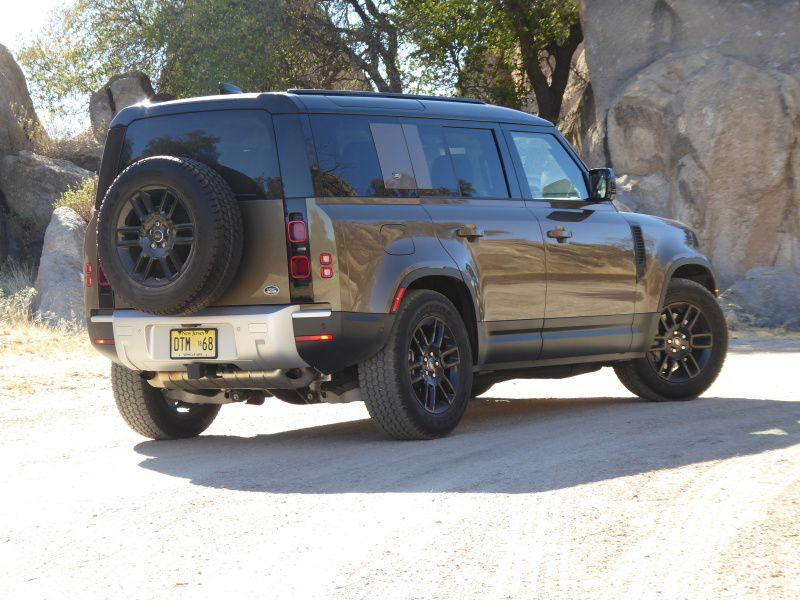
Photo by Ron Sessions
Interior Design and Features
The Defender’s minimalist yet luxurious cabin is highlighted by a powder-coated magnesium cross-vehicle beam that’s a visible and key component of the Defender’s aluminum unitized body. Grips on the upper section of the beam double as assist handles for ingress or egress or just hanging on during more aggressive off-road maneuvers. Switchgear is reduced to a minimum, with most controls sequestered to a small shelf beneath the standard 10-inch infotainment screen.
The exposed structure theme extends to the doors and console. There is an abundance of storage space up front with roomy pockets in the doors, the open dash, and the two-tier center console. Standard in upper four-door models is a power sliding panoramic glass sunroof. Also just rolling out in two- and four-door versions is an available sliding fabric sunroof big enough for rear-seaters to stand up and survey the terrain “safari” style. It’s a stretch climbing in, but once there, the front seats of the high-roof SUV offer generous head- and legroom. The front buckets are supportive and comfortable, with no large lateral bolsters to slide over getting in and out. Materials look and feel sufficiently rugged, with cloth seat upholstery in lower trim levels and leather or leather and wool-blend textile coverings higher up the price ladder.
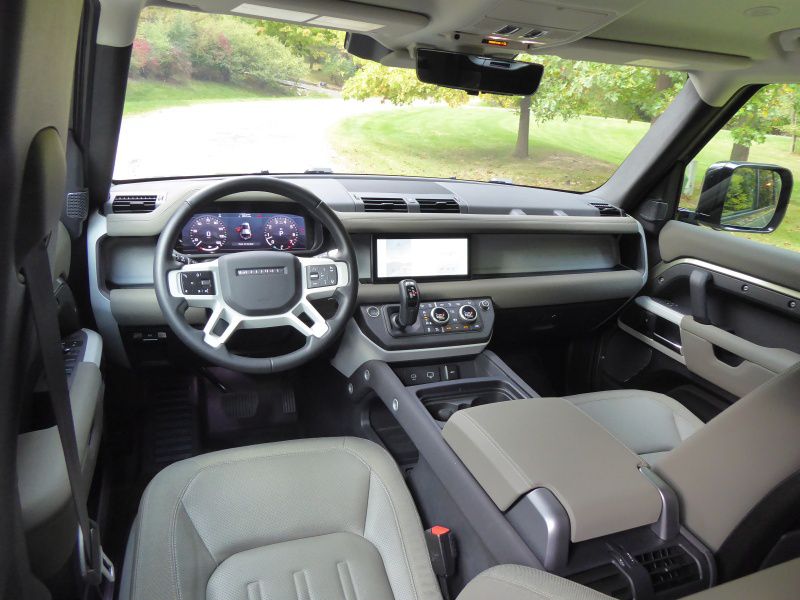
Photo by Ron Sessions
Turbo Power
There are two engines available: a 2.0-liter turbocharged four-cylinder and an Ingenium 3.0-liter turbocharged inline-six with electric boost, the latter shared with some Range Rover and Jaguar models. Both are teamed with an eight-speed ZF automatic transmission and four-wheel drive.
Equipped with a fast-responding twin-scroll turbo, the four-cylinder makes 296 horsepower and 295 lb-ft of torque and is available only in the base and S trims. It can move the near 5,000-lb Defender from rest to 60 mph in just under 8 seconds. EPA estimates are 17 mpg city/20 mpg highway/18 mpg combined. Powering all other versions of both body styles is the turbocharged 3.0-liter six-cylinder mild hybrid. It’s equipped with a 48-volt lithium-ion battery and electric starter/generator. Like a small electric supercharger, the system boosts output while the gas engine’s turbocharger is spooling up to quicken throttle response. The hybrid battery is recharged when the vehicle is coasting or decelerating. The six-cylinder makes a healthy 395 hp and 406 lb-ft of torque and can accelerate to 60 mph in just under 6 seconds. The mild-hybrid six-cylinder turbo is more fuel-efficient than the more basic four-cylinder, achieving EPA estimates of 17 mpg city/22 mpg highway/19 mpg combined. Max towing with either engine is a healthy 8,201 lbs.
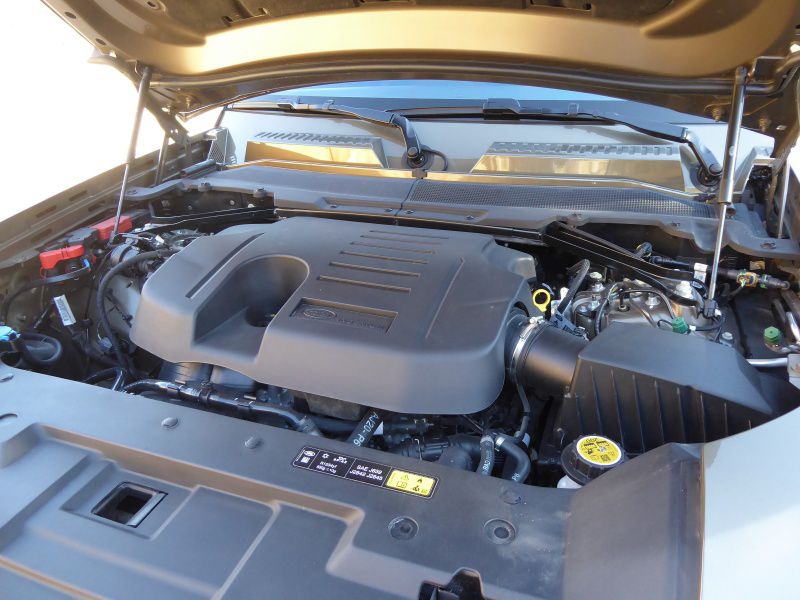
Photo by Ron Sessions
Control Panel
Adding some functionality to the otherwise minimalist dash is this small control panel. It houses switchgear for the climate control system as well as the low-range transfer case, traction control, and auto stop-start off buttons, hill-descent control, push-button starter, and — on Defenders so equipped — the ride-height adjustment for the air suspension. It also provides a way to move through the drive mode menus for the Terrain Response system.
Moving the shifter off the console to the small shelf at the center of the dash frees up open storage space atop and just under the console and helps make room for an optional front center jump seat between the front buckets. It’s not much of a perch because the occupant has to straddle the console, but it technically gives the Defender four-door a passenger capacity of six to eight.
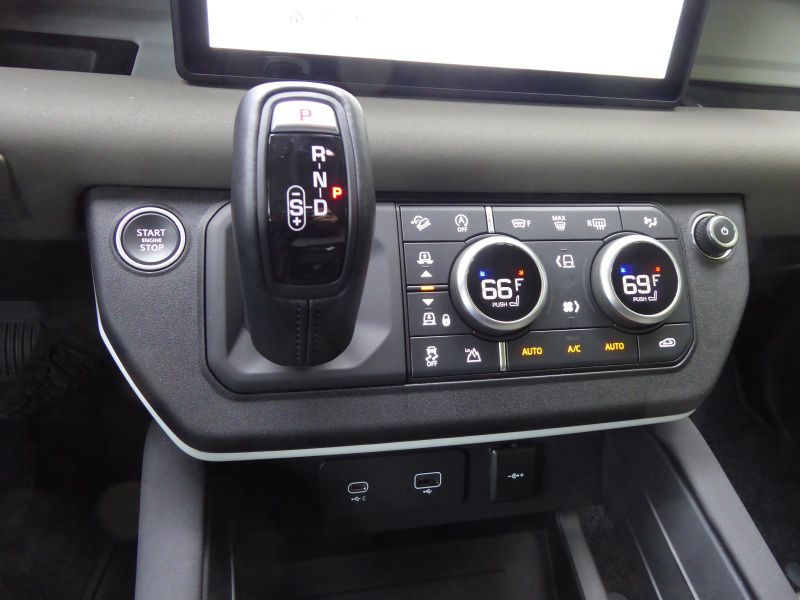
Photo by Ron Sessions
Meet Pivi Pro
The new Pivi Pro infotainment system launched with the Defender centers around a dash-mounted central touchscreen within easy reach of the driver and front passenger. It dispenses with complicated remote control pads or wheels. There is an analog rotary knob for volume on a panel under the screen; all other infotainment system controls such as station tuning are virtual ones on the 10-inch touchscreen, steering-wheel hard buttons, or voice controls. The screen offers good resolution and quick response to inputs but the display’s delicate fonts and muted, low-contrast gray, green, or beige colors that may be pleasing in a decorative sense are not always easy to read on the fly.
The center screen can display up to three panels, such as navigation, media, or phone, or just one with greater detail. In higher trims, the navigation map also can migrate to the driver display. The menus for some driving controls such as the configurable terrain response are also accessed from the screen. Apple CarPlay and Android Auto cellphone mirroring are standard on all trims. The base AM/FM stereo includes HD Radio and three months of SiriusXM satellite radio. SE and higher trims upgrade to an 11-speaker 400-watt Meridian audio system while the X trim brings a 15-speaker 825-watt Meridian system.
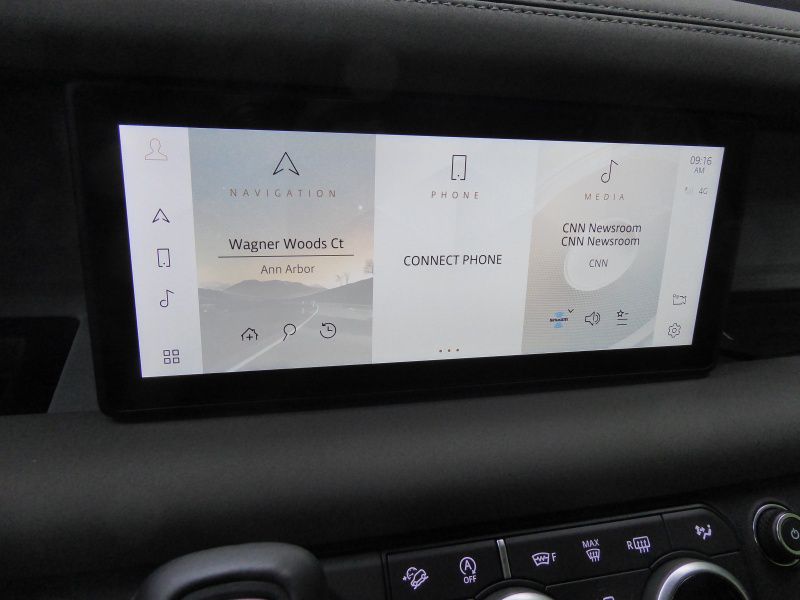
Photo by Ron Sessions
Back Seat
The test vehicle was a five-passenger four-door Defender 110 offering plenty of headroom and legroom for back-seat passengers. Step-in height is high, but well-placed assist handles aid the ascent. Passengers entering the rear of the two-door 90 model need to squeeze past the tilted front bucket seat and, once back there, will find about 2 inches less head- and legroom back there than in the four-door 110.
The standard 40/20/40 split seatback in both Defender 90 and 110 models has a handy fold-down center armrest with built-in cup holders and its configuration allows plenty of flexibility when divvying up space for passengers and cargo. To fold down the rear seat sections, you must first flip forward the bottom seat cushion. A third-row seat, only available as an option in the long-wheelbase Defender 110, is tiny and not suitable for adult habitation.
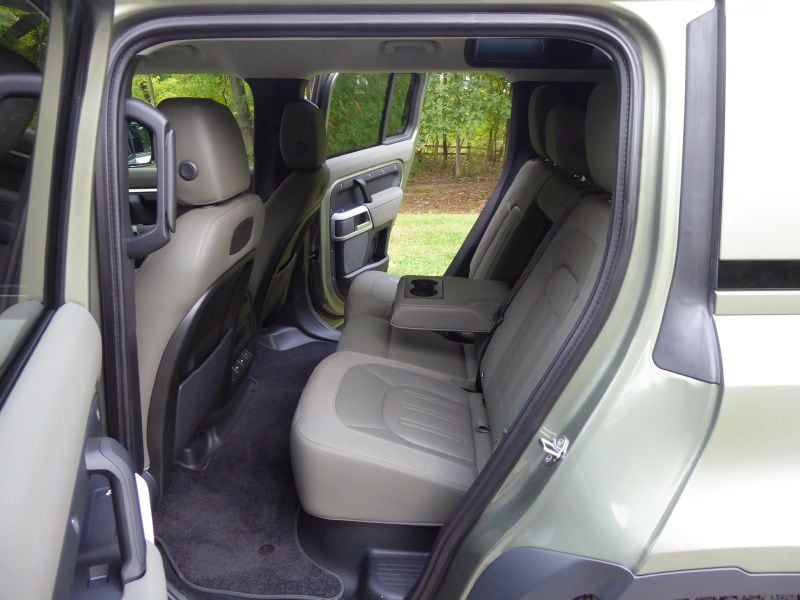
Photo by Ron Sessions
Cargo Room
Instead of a liftgate as on most of today’s SUVs and crossovers, the Defender’s tall and sturdy-feeling rear cargo door, upon which the full-size spare tire is mounted, swings out to the right. This is a minor inconvenience in left-hand-drive countries like the U.S., as the opened door partially blocks curb-side access.
Inside, the no-nonsense, washable, rubberized-floor cargo hold of the high-roof SUV is a welcoming tall box. Grippy nubs in the flooring and a pair of load space rails with tie-down rings for mounting nets and load retention accessories keep stuff from moving around. There’s 34 cubic feet of space behind the second-row seat of four-door models, which shrinks to 15.6 cubic feet in the two-door. In four-door Defenders with the optional third-row seat, cargo room is a sports coupe-like 10.7 cu ft aft of the rearmost seatback. Drop all seats behind the fronts and available cargo space ranges from a handy 58.3 cu ft in the 2-door Defender 90 to a voluminous (as shown above) 78.8 cu ft in the 4-door 110. There is also a small amount of hidden storage under the cargo floor.
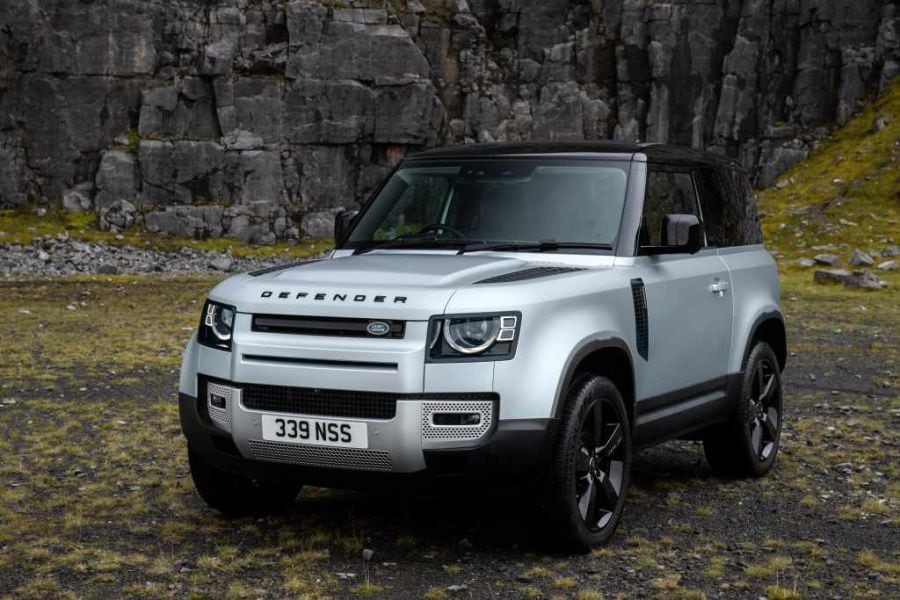
Photo by Jaguar Land Rover
Safety and Driver-Assistive Tech
The previous generation of the Defender last sold in the U.S. in 1997 didn’t even have front airbags. That’s all changed for the new version. Designed from the get-go to meet tough safety standards in Europe, Asia, and North America, the 2021 model rolls with six airbags and a long list of safety and driver-assistive systems. Standard equipment includes a 3D surround camera, blind-spot detection, lane-keeping, automatic emergency braking, front and rear parking sensors, a driver attention monitor, and traffic-sign recognition. S and higher trims bring automatic high-beam control, and the X Dynamic and HSE add adaptive cruise control.
Thanks to the tall windows, outward vision to the front and sides is pretty good, but it is restricted to the rear by tall head restraints, thick rear roof pillars, and the rear-mounted spare tire. That situation is addressed by the available rearview camera mirror that can present a wide-angle display from a rear door-mounted camera — bypassing the heads of rear passengers, tall cargo, and such inside the vehicle. A conventional backup camera with a dashboard display is also standard equipment.
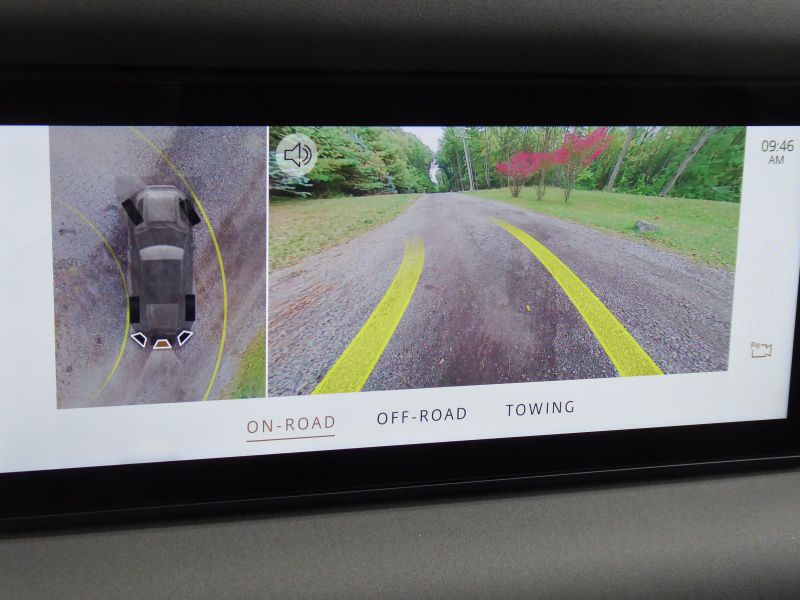
Photo by Ron Sessions
Drive Modes
Aside from permanent four-wheel drive and Terrain Response, the new Defender is available with an optional locking center differential and active locking rear differential to get the plucky SUV through all manner of off-road challenges. Additionally, there are six configurable drive modes available in the Defender’s Terrain Response 2 system: Normal, Mud and Ruts, Grass/Gravel/Snow, Sand, Rock Crawl, and (something you won’t see in other systems) Wade.
Like it sounds, the Wade mode is the one you’ll want when fording through water. On models with the air suspension, it extends the suspension to full off-road ride height (11.5 inches), locks the drivetrain, softens throttle response, reduces traction control intervention, switches climate control to recirculation mode, and lightly applies the brakes upon exiting the water to help dry them. Ultrasonic sensors in the side mirrors display the water depth in the center screen. Unless it’s equipped with the optional high-mounted air snorkel, the maximum fording depth (to avoid sucking water into the engine’s air intake) with the suspension at full height is 35.4 inches.
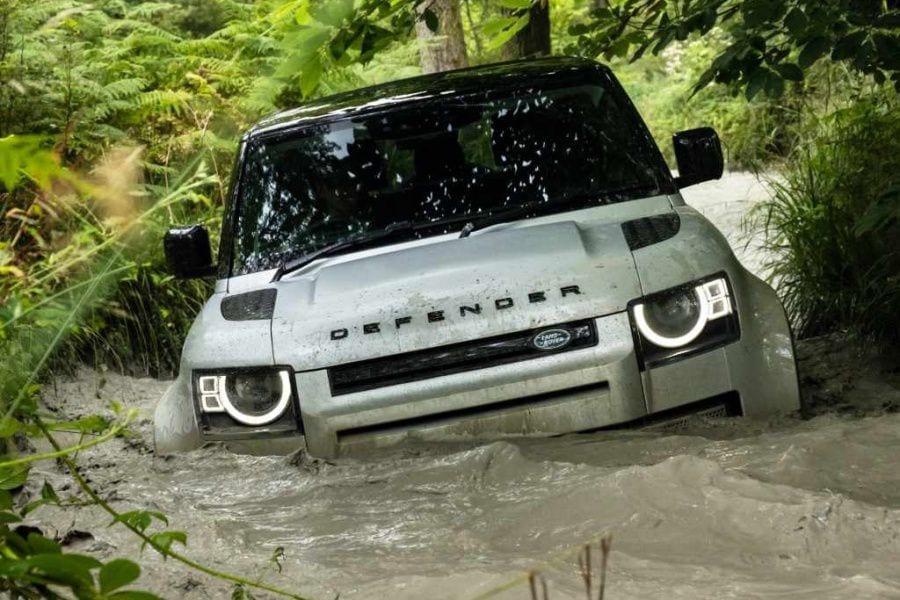
Photo by Jaguar Land Rover
Serious Capability
The new Defender may hark back to simpler times but as the latest addition to the Land Rover luxury brand, the plucky off-roader comes well equipped with a modern chassis and advanced four-wheel-drive systems. An air suspension and adaptive dampers are standard with all 110 trims, as well as 90 X and 90 First Edition models. With the smooth-riding air suspension, the Defender’s ride height is adjustable from 8.6 inches at rest to 11.5 at full off-road height.
Just the more basic versions of the short-wheelbase Defender 90 get steel coil springs and conventional gas-charged dampers. There are 12 wheel designs available, ranging from 18-inch steel rims to 22-inch alloys. Our Defender 110 test vehicle with air suspension and adaptive dampers provided good vertical body control. Even with the large 20-inch wheels and Goodyear Wrangler off-road tires, impact harshness over ruts wasn’t an issue. The Defender’s electric boosted steering was well-weighted and precise. Taking some getting used to, however, were the electrically boosted brakes, which could be grabby on hard snubs.
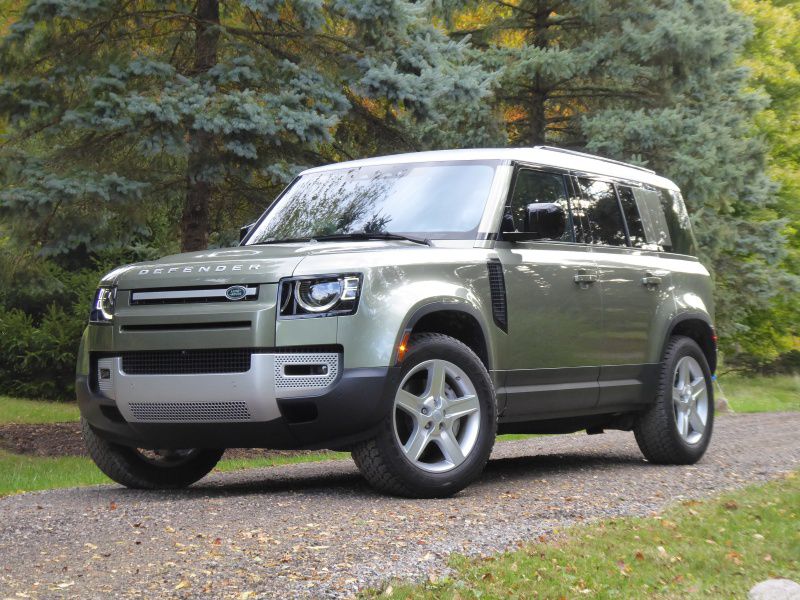
Photo by Ron Sessions